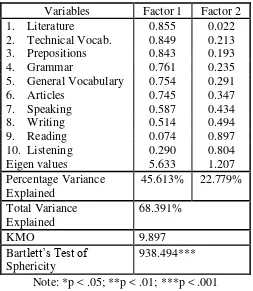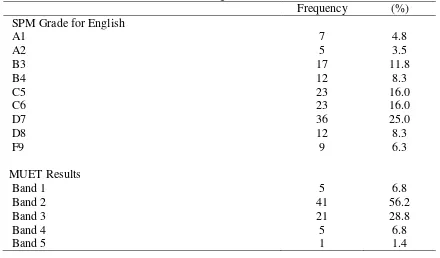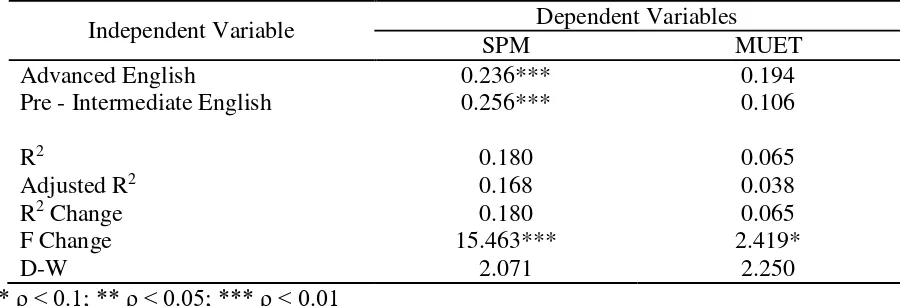292
ENGLISH ABILITIES AND KNOWLEDGE OF ADULT LEANERS: A
CASE STUDY OF STUDENT AT THE SCHOOL OF DISTANCE
EDUCATION, UNIVERSITI SAINS MALAYSIA
SHAHRIER PAWANCHIK, FAIZ HILMI, MEOR AZLI, ISSHAM ISMAIL
School of Distance Education, Universiti Sains . Malaysia 11800 Penang, Malaysia. E-mail: [email protected]
ABSTRACT
The decline in English language proficiency among students entering public universities is still debatable. English may be taught from standard one through form five and form six or matriculation level but the students’ proficiency is still very low. Looking at in microcosm, the majority of Malaysian students leave the school system with a poor grasp of English despite having been exposed to the language for eleven or more years. Although both the ‘intrinsic and extrinsic motivations’ have been given, these motivations have been unsuccessful in reaching the greater majority. Employers especially from the private sector have voiced their concern on the low proficiency of these graduates. And the repercussion is employers will look elsewhere for skilled workers instead of employing public institutions’ graduates. Taking the cue from here, this research paper will focus on the abilities and knowledge of adult learners who are doing distance education programmes with the Universiti Sains Malaysia. These students are working either in the public or private sector. Findings of this research will provide information for curriculum developers at public institutions of higher
learning to tailor their English courses towards meeting the students’ needs.
Introduction
The decline in English language proficiency among students entering public universities is still debatable. English may be taught from standard one through form five and form six or matriculation level but the students’ proficiency is still very low. Looking at in microcosm, the majority of Malaysian students leave the school system with a poor grasp of English despite having been exposed to the language for eleven or more years. Although both
‘intrinsic and extrinsic motivations’ have been given, these motivations have been unsuccessful in reaching the greater majority. Employers especially from the private sector have voiced their concern on the low proficiency of graduates. And the repercussion is employers will look elsewhere for skilled workers instead of employing public institutions’ graduates.
293
their English courses towards meeting the students’ needs.
Problem Statement
In 2008, USM was selected a research university with apex status, hence the expectations of its stakeholders (the ministry of education in Malaysia, employers, students,
parents, lecturers and the general public) have also increased. The increased in students’
enrolment at SDE, USM has raised the question of students’ proficiency in English. Taking the cue from here, this research starts with the premise that students entering public universities are not proficient in English, their abilities and knowledge to operate in the language at the tertiary level are debatable. The following research questions will be investigated:
i. How do the adult students rate their English language abilities and knowledge ii. What are the principal attributes of English showed by the students?
iii. How is English language abilities and knowledge correlated to Malaysian University English Test (MUET) grade?
Approach
The methodology underlying this research is guided by the protocol of Hutchinson and Waters (1987) and refined by Basturkmen (1998) model of needs analysis. The researchers use
questionnaire to elucidate information on the students’ proficiency in English. It is divided into
three sections: (1) Section I—Background information. It will yield findings that relate to the
participants’ demographic backgrounds; (2) Section II—Language abilities and knowledge.
Findings from this section will yield insights into the participants’ own assessment of their
abilities and knowledge in English; (3) Section III— English language abilities and knowledge correlated to Malaysian University English Test (MUET) grade.
The researchers believe that information gathered from the questionnaire will permit considerable insights into the students abilities and knowledge of English. The participants in this research are second year SDE students for the academic year 2010/2011 at USM. They have either passed the preparatory English course or secured band 4 of MUET. 159 students responded to this research.
Results
294 knowledge?
Table 1: Descriptive Statistics for Abilities and Knowledge of English
Variable Mean Standard Deviation
1. Reading 1.86 0.604
2. Writing 2.20 0.488
3. Speaking 2.20 0.562
4. Listening 1.98 0.547
5. Grammar 2.29 0.544
6. General Vocabulary 2.28 0.553
7. Technical Vocab. 2.38 0.570
8. Articles 2.28 0.529
9. Prepositions 2.30 0.537
10. English literature 2.41 0.587
Van Ek (1975:2) mentions that an individual needs will undoubtedly vary widely, yet organized education can only cater for the individual learner if he can be regrouped with other learners to form a sufficiently large class to justify the efforts and finances required to satisfy his needs. The problem is not so much of specifying in detail the needs of an individual learner but rather the problem of identifying needs shared by a substantial number of learners. Pragmatic considerations dictate that the enthusiasm to base language programmes on a prior, careful specification of communication needs ought to take into consideration the fact that not all individual needs can realistically be satisfied.
Table 1 shows a descriptive analysis (based on the 10 variables) of the students’ own
295 listening easier language skills to acquire. The rest are difficult components to acquire.
Research question 2: What are the principal attributes of English showed by the students?
Table 2: Result of Factor Analysis on Abilities and Knowledge of English
Variables Factor 1 Factor 2 learner needs the language for now) or future, hypothetical needs (what the learner may want the language for at some unspecified time in the future). Other types of needs are considered as learner desires (what the student would like to do with the language, independent of the specific requirements of the situation) and teacher-created needs (what the teacher imagines is needed or would like to impose on the learner).
Table 2 gives principal attributes of English that are exhibited by the respondents. The results show a two factor division with Eigen values greater than 1.0 and the Total Variance explained was 68.391%. KMO measure of sampling adequacy was 9.897 which indicates
sufficient inter correlations while Bartlett’s test of sphericity was significant ( 2 = 938.494, p < .001).
The researchers label factor one as Advanced English with loading between 0.514 and 0.855. The students treated these eight variables (in order of difficulties - from literature to writing) as difficult language components. They perceive that these components are advanced level. The researchers label factor two (Item 9 - Reading with loading 0.897 and Item10 - Listening with loading 0.804) as Pre - Intermediate English. These two items are considered easier skills to acquire.
296
Table 5: Correlation Matrix of the Research Variables
1 2 3 4
297 is continuity of proficiency from SPM, MUET and Pre - Intermediate English.
Table 6: Regression Analysis
Independent Variable Dependent Variables
SPM MUET
Advanced English 0.236*** 0.194
Pre - Intermediate English 0.256*** 0.106
R2 0.180 0.065
needs based on the students’ performance in relation to the MUET scores. It touches on the
need for an analysis of the learner’s language abilities and knowledge before an English course
is designed. Mundy considers this feature a key instrument. According to Robinson (1991) language learning is not due to interest on the language culture but for specific work purposes. Table 6 displays the results of a relationship between the variables under this research, the combination of Advanced English and Pre - Intermediate English explained 16.8% of the proficiency of English at SPM level, and 3.8% of the variance in MUET performance. Since all the F values are significant, as a group, both Advanced English and Pre - Intermediate
English variables reliably predict the SPM and MUET variables. Advanced English (β = 0.236,
ρ < .01) and Pre - Intermediate English (β = 0.256, ρ < .01) are found to be positively related
to proficiency of English at SPM level. However, Advanced English (β = .194, ρ > .01) and
Pre - Intermediate English (β =0.106, ρ > .01) are found to be insignificantly related to proficiency in MUET.
The paradox is proficiency in English at MUET level exhibit no significant correlation with proficiency of Advanced English (r =0.110, n = 159, p > 0.05). It means that even though the students are proficient at MUET level, it does not mean that these students will score higher grades for Advanced English. The reason could be the students find all eight items of Advanced English as difficult components to acquire.
Discussion
This research focuses on analyzing the students’ own assessment of their abilities and knowledge of English. All the SDE students are working adults either in public or private
sector. The first research question looks at the students’ own assessment; the score is low for
the first eight items (means are between 2.20 to 2.41) except for reading and listening (means at 1.86 and 1.98). These two skills are considered are easier to acquire. Students who are fairly fluent, use English fairly appropriately and make many grammatical errors are termed ‘modest
users’ under MUET. So the respondents fall under this category.
298 items 9 and 10. Refer to table 2. The students treated items of Advanced English (in order of difficulties - from literature to writing) as difficult language components and it is appropriate to place them in the advanced teaching and learning stage. However, the last two skills, reading and listening, are considered easier and placed in the pre - intermediate stage.
The third research questions focus on identifying the correlation between the students’
abilities and knowledge in English in MUET, Pre - Intermediate English and Advanced English. Proficiency in English at SPM level correlates positively with proficiency of MUET and Pre - Intermediate English. There is a continuity of proficiency from SPM, MUET and Pre - Intermediate English. However, Advanced English was insignificantly related to proficiency of MUET. It means that even though the students are proficient in MUET, it does not mean that these students will score higher grades for Advanced English.
References
Basturkmen, H. (1998): Refining Procedures. The Internet ES Journal. Vol. 36 No.4, Oct.- Dec. 1998.
Hutchinson, T. And Waters, A. (1987): English for Specific Purposes. A Learning – Centred Approach. Cambridge University Press.
Mackay, R. and Bosquet, M (1981): LSP Curriculum Development – From Policy to Practice in Mackay, R. and Palmer, J.D. (Eds) (1981).
Mc Arthur, T. (1996): English Today. Cambridge University Press.
Munby, J. (1978): Communcative Syllabus Design. Cambridge, Cambridge University Press. Nunan, D. (1985): Syllabus Design. Oxford. Oxford University Press.
Robinson, P.C. (1991). ESP Today: A Practitioner's Guide. London: Prentice Hall. Van Ek, J.A. (1975): The Threshold Level. Council of Europe, Strasbourg.
Widdowson, H.G. (1974): An Approach to the Teaching of Scientific English Discourse. RELC Journal 5,1. Singapore.
Widdowson, H.G. (1987): English for Specific Purposes. Criteria for Course Design In Long and Richards (Eds). (1987).



